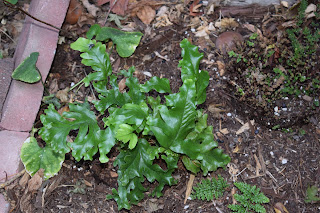Not going to wax poetic but in this time of sheltering and minimal contact with friends, my garden is even more of a treasure. I am lucky to have a garden with year round interest so I can go out on any given day and there is much to love and appreciate. Even the work - weeding, pruning, deadheading - is a balm these days.No matter the nature of your garden, I hope it is bringing you solace these days.
And now the photos!
Here's my new Calibrachoa. We probably sell more of these at our nursery as a hanging basket plant than almost any other plant.
Erica speciosa. For some reason the foliage shows more chartreuse here, when it's really a rich green. A near constant bloomer.
Mandevilla Apricot. An unusual color for a Mandevilla, which are normally red, pink or white.
If this fluffy seedpod looks familiar, it isn't what you think (Asclepias). This Tweedia is however a member of the same milkweed family. The fluff, with tiny black seeds embedded, allows the wind to disperse the seed.
Helichrysum Lemon Licorice. This is a sturdy little ground cover. Pretty too!
Mimulus Betabel. Mimulus are very long bloomers, especially if they get a little regular water.
Grevillea Superb. One of our best selling Grevilleas and here's why. The colors are usually a bit deeper but they do go through a change from bright red to soft orange to cream.
Lobelia may be common but it's an easy way to add wonderful blue colors to the garden.
Here's my sweet kitty in repose as her caretaker does all the garden work!
Ceratostigma plumbaginoides (plumbago) is a wonderful late fall and winter ground cover and another way to add intense blue flowers to a sunny spot.
Although the more vibrant yellows of spring are gone, there's still plenty of bright tones left on my Cistus McGuire's Gold.
My Sideritis cypria has been a revelation. First the intense and true silvery foliage, then the curious lime bracts and the tiny yellow flowers nestled inside these bracts.
Mina lobata is another plant whose flowers go through a color change, as you can readily see here.
Aloe arborescens variegata. This super easy to grow aloe makes do with any kind of soil and sun or light shade, plus next to no water.
Calamintha. Bees love this Calamint, although my cat is so far ignoring it. Mind you, she has her own patch of Nepeta (catmint) to enjoy.
Rain lily flowers may be simple but they do add a splash of white to a fall garden.
The fine textured plant here is Chamaecyparis pisifera 'Snow.' It's already a dwarf variety (to 14") but I'm growing it as a bonsai so it really will stay small. Love that delicate texture.
Begonia Gene Daniels. It's hard to see here but this begonia has rich, velvety red undersides and then in early fall sprays of these pink flowers.
I'm still not sure which Plectranthus this is, having taken a cutting from a friend's garden.
Begonia 'Fannie Moser.' This angel wing begonia features super dark leaves. Nice!
Yes, it's the parade of begonias. Here's my B. acetosa, with its sprays of simple white flowers.
Phlebosia Nicolas Diamond. Love this new fern!
Aechmea 'Pickaniny x White Knight.' This variety is noteworthy for its dark banding on the undersides of the leaves.
One last Begonia, this one Autumn Ember. Here I love the way the light is playing in a multitude of ways off the various leaves.
Tillandsia tectorum. Still the king of silver tillandsias.
Rhipsalis species. I've lost the tag for this one but it's very happy and tumbling out of a pretty small pot.



























No comments:
Post a Comment